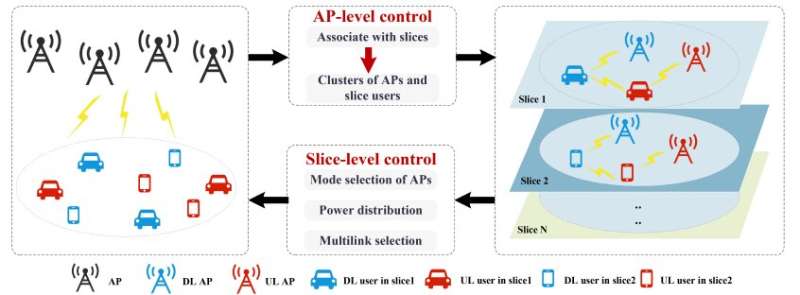
Network-assisted full-duplex (NAFD) systems enable uplink and downlink communications within the same time-frequency resources, so as to avoid the overhead of switching uplink/downlink modes. However, as the number of users and access points (APs) proliferated, mass access brings significant overhead in mode selection.
In addition, the differentiated service demands among users also makes the effective utilization of resources difficult. Combined with network slicing technology, a slicing capacity-centered mode selection and resource optimization scheme is proposed.
This scheme adopts a double-layer deep reinforcement learning mechanism, through the clustering cooperation and resource isolation of APs, which not only realizes the adaptive configuration of uplink and downlink resources, but also adapts to the expansion of network scale and responds quickly to environmental changes. Compared with traditional schemes, flexible expansibility and user requirements are effectively taken into account.
A paper published in Science China Information Sciences proposes a slicing capacity-centered mode selection and resource optimization scheme. The combination of network slicing and NAFD technology not only further improves the utilization rate of limited resources, but also satisfies customized services of users. In addition, APs and slices form different subsystems to create a new paradigm for mode selection, which can reduce the cost of collaboration.
In order to effectively implement the scheme, this paper proposes a double-layer deep reinforcement learning mechanism which can adapt to the long-term trend of slicing demand. The upper-layer uses DQN algorithm to obtain the association scheme between APs and slices according to the feedback information of the lower layer and the traffic state.
The lower-layer realizes mode selection and resource allocation in each subsystem by MADDPG algorithm according to the upper-layer association scheme and local network state. The double layers are coupled and feedback to each other.
The innovations of this paper are as follows:
- Network slicing is introduced to assist NAFD technique so as to reduce the pressure of contention for resource through resource isolation among users.
- APs are motivated by slicing requirement to associate different slices to form different subsystems, and mode selection and resource allocation are jointly optimized within each subsystem.
- Double-layer deep reinforcement learning mechanism is proposed. The upper-layer control policy uses DQN to form flexible duplex AP-slice subsystems. The lower-layer control policy uses MADDPG to select working mode cooperatively and perform radio resources allocation in each subsystem.
The slicing capacity-centered scheme and double-layer deep reinforcement learning mechanism proposed in this paper are verified in the PYTHON platform. Simulation results show that compared with the traditional global capacity-centered scheme, the proposed slicing capacity-centered mode selection and resource optimization scheme not only improves the system performance, but also improves the adaptation of slicing demand and slicing utility to meet the customization requirements of users by optimizing the association scheme between APs and slices.
In addition, compared with the static resource allocation scheme and K-means-MADDPG learning mechanism, the double-layer deep reinforcement learning mechanism achieves better system performance through the cooperation between APs, which further proves that the proposed double-layer deep reinforcement learning mechanism realizes real-time optimization of the network through mutual feedback between the upper and lower layers.
More information:
Wang J et al. Slicing capacity-centered mode selection and resource optimization for network-assisted full-duplex cell-free distributed massive MIMO systems, Science China Information Sciences (2023). DOI: 10.1007/s11432-022-3697-x
Citation:
Slicing capacity-centered mode selection for network-assisted full-duplex cell-free distributed massive MIMO systems (2023, February 15)
retrieved 15 February 2023
from https://techxplore.com/news/2023-02-slicing-capacity-centered-mode-network-assisted-full-duplex.html
This document is subject to copyright. Apart from any fair dealing for the purpose of private study or research, no
part may be reproduced without the written permission. The content is provided for information purposes only.
For all the latest Technology News Click Here
For the latest news and updates, follow us on Google News.

